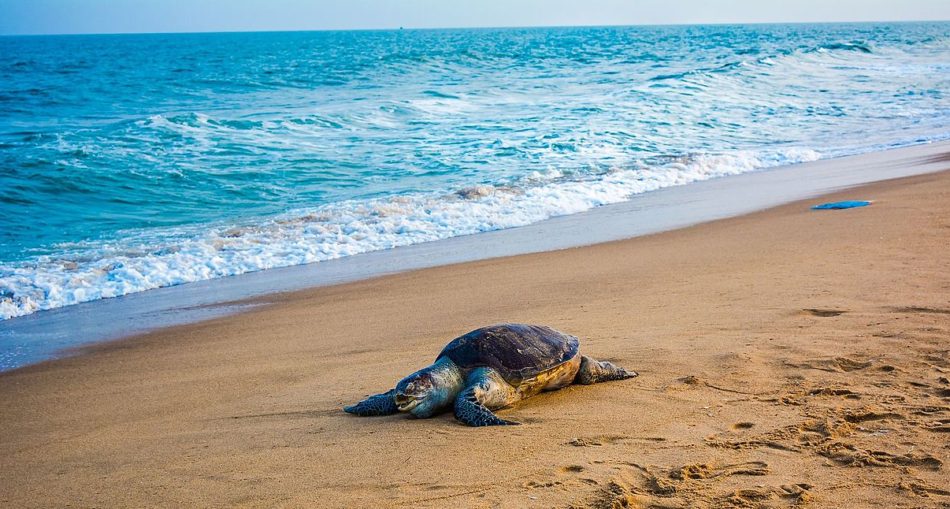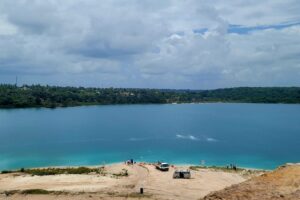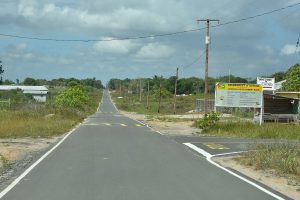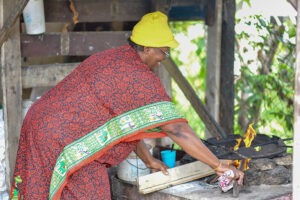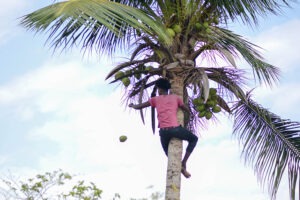The Olive Ridley Sea Turtle, named after the olive-green hues of its rounded, heart-shaped shell is the second smallest and most copious of marine turtles. The scientific name of the species is Lepidochelys olivacea but it is commonly referred to as the Pacific Ridley Sea Turtle. It is typically found in the warm and tropical waters of the Pacific Ocean, Indian Ocean, and warmer waters of the Atlantic Ocean. In Guyana, the species can be found nesting on Shell Beach, in Region One, Barima Waini, on the North Atlantic Coast of Guyana close Venezuela’s border. The species is popular for its mass nesting having over three hundred (300) turtles simultaneously going ashore. There are several factors which inhibit this generational cycle including climate change. To combat this, Dr. Peter Pritchard and Romeo De Freitas founded the Guyana Marine Turtle Conservation Society, a non-governmental conservation program to help protect Guyana’s marine turtles of from hunting, loss of habitat due to erosion and hunting, fishing and sea pollution.
Interesting Tip
- Shell Beach is also the nesting ground for three other sea turtle species, Green, Hawksbill turtle, and the Leatherback.
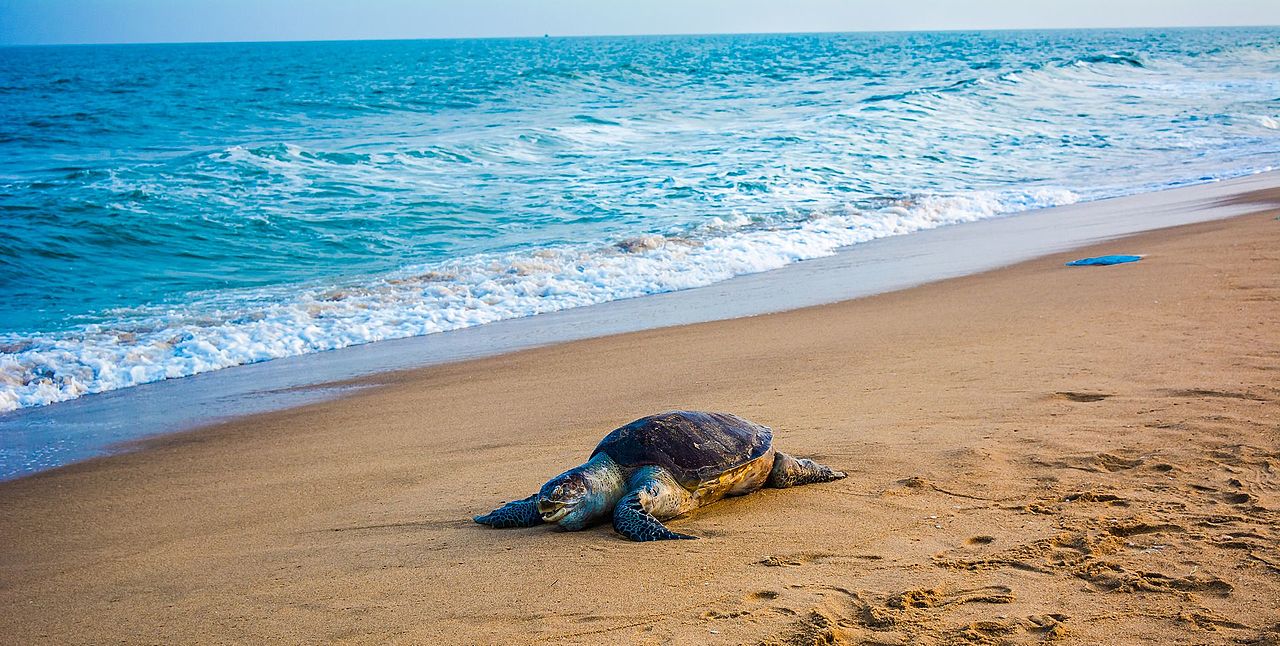
The Olive Ridley Sea Turtle – Photo By Pinku Halder – Own work, CC BY-SA 4.0, https://commons.wikimedia.org/w/index.php?curid=60120634
Features Of The Olive Ridley Sea Turtle
- Colour – The carapace of the Olive Ridley Sea Turtle is greyish-green to olive-green, however, the algae growing on its carapace can cause the reptile to look reddish. The bridge and hingeless plastron of adult turtles are creamy yellow while that of the younger ones are a greenish-white.
- Shape – The Olive Ridley Sea Turtle has a medium-sized, and broad head. Dorsally, their carapaces are flattened with its highest anterior towards the bridge. The heart-shaped carapace of the Olive Ridley Sea Turtle grows up to sixty-one (61) cm in length and is made up of four (4) pairs of pore-bearing inframarginal scutes on the bridge, two (2) pairs of prefrontals, and about nine (9) lateral scutes per side. One unique feature of the Olive Ridley Sea Turtle has is variable and asymmetrical lateral scute counts, with around five to nine (5-9 ) plates on each side. Twelve to fourteen (12–14) marginal scutes can be found on either side of the carapace. Hatchlings have a carapace length of thirty-seven to fifty (37-50) mm, with a thin white line bordering it, as wells as their fore and hind flippers. Hatchlings and juveniles have serrated posterior marginal scutes, which smoothens as they age.
- Limbs – Its forelimbs resemble paddles with two anterior claws. Adult males have longer, and thicker tails, enlarged and hooked claws on their front flippers.
- Weight & Length – The heart-shaped carapace of Olive Ridley Sea Turtles grows up to sixty-one (61) cm in length. The average weight of female Olive Ridley Sea Turtle is thirty-five (35) kg compared to their male counterparts who weight around thirty-three (33) kg. The hatchling’s weight ranges from twelve to twenty-three (12-23) g.
Scientific Classifications Of The Olive Ridley Sea Turtle
Olive Ridley Sea Turtle – Lepidochelys olivacea [Scientific name]
- Kingdom: Animalia
- Phylum: Chordata
- Class: Reptilia
- Order: Testudines
- Suborder: Cryptodira
- Superfamily: Chelonioidea
- Family: Cheloniidae
- Genus: Lepidochelys
- Species: L. olivacea
Habitat Of The Olive Ridley Sea Turtle
The Olive Ridley Sea Turtle can be found in countries such as Guyana, Suriname, Brazil, French Guiana, India, Japan, Arabia, Africa and in the Caribbean Sea. The Olive Ridley Sea Turtle uses a number of habitats during its life but they are often seen within fifteen (15) km of mainland shores, shallow marine waters with depths of about twenty-two to fifty-five (22–55) m. Sometimes they can be found in open water.
Diet Of The Olive Ridley Sea Turtle
The diet of the Olive Ridley Sea Turtle primarily consists of invertebrates of shallow marine waters or estuarine habitats. These include shrimp, snail, crab, rock lobsters, and sea urchins but will feed on filamentous algae when food is scarce. In open oceans feeding the turtle tends to consume fish, fish egg and jellyfish.
Interesting Tip
- Estuarine habitats are places where the saltwater/ocean water mixes with freshwater from the land.
Reproduction Of The Olive Ridley Sea Turtle
The annual migration of Olive Ridley Sea Turtles begins in from March to August but this depends on location. However, they tend to gather near nesting beaches a few months before the nesting seasons starts. Females are able to lay as many as three (3) clutches per season since they store the sperm. Before laying her eggs, the female Olive Ridley will make a nest thirty to fifty-five (30-55) cm deep and about fifty (50) m from the sea. Their clutch size ranges from thirty to one hundred sixty-eight in Suriname while in the eastern Pacific the average was one hundred and five (105) eggs. The incubation lasts around forty-five and fifty-one (45- 51) days but may lengthen in poor weather.
Interesting Tip
- Incubation temperatures can determine the sex of the turtles; eggs incubated at31 to 32 °C produce only females while eggs incubated at 28 °C or less produce only males. A temperature at around 29 to 30 °C will produce a mixed-sex clutch.
6 Facts About The Olive Ridley Sea Turtle
- From the above view, the head of the Olive Ridley Sea Turtle looks triangular.
- It is not often that an Olive Ridley weighs over 50 kg (110 lb).
- While male and female Olive Ridleys reach approximately the same size, the carapace of the females is a bit more rounded.
- The central longitudinal keel of juveniles produces a serrated profile, which remains until sexual maturity is reached.
- The female Olive Ridley Sea Turtle can recall the smell of the beach where she was born via enhanced chemosensors.
- The word Lepidochelys, is derived from the Greek words lepidos which means scale, and chelys, meaning turtle while olivacea is derived from the colour of its carapace.
Status Of Conservation Of The Olive Ridley Sea Turtle
The Olive Ridley Sea Turtle (Lepidochelys olivacea) is listed as vulnerable in the International Union for the Conservation of Nature (IUCN). Additionally, the Guyana Marine Conservation Society (GMCS), the Wildlife Management Authority, World Wildlife Fund (WWF) and the Environmental Protection Agency (EPA) all work to conserve the sea turtles species. The species is listed on Schedule – I of the Indian Wildlife (Protection) Act, 1972 (amended 1991) in India, which hosts the most colossal and known breeding colony of Olive Ridleys in the Gahirmatha Marine Wildlife Sanctuary. The species is also protected under the ‘Migratory Species Convention’ and Convention of International Trade on Wildlife Flora and Fauna (CITES).
Olive Ridley Sea Turtles In Guyana
The Olive Ridley Sea Turtle, commonly called the Olive Ridley is one (1) of four (4) species of marine turtles which come ashore to Guyana to lay their eggs. Others include the Leatherback, Hawksbill, and Green Turtles. Like all sea turtles, the Olive Ridley Sea Turtles always return to their birthplace to lay their eggs. However, due to climate change, the beaches are being washed away. Pollution of the ocean among a number of other factors also add to difficulties in their return. There have been efforts to protect these turtles in places around the world. The Shell Beach in Guyana is a protected area for the marine turtles where you can visit and observe the various species.
Article References
- https://animaldiversity.org/accounts/Lepidochelys_olivacea/
- https://www.atlasobscura.com/places/shell-beach-turtles
- https://www.kaieteurnewsonline.com/2013/06/30/endangered-marine-turtle-populations-increasing-in-guyana/
- https://guyanachronicle.com/2017/05/14/know-your-sea-turtles/
- https://en.wikipedia.org/wiki/Olive_ridley_sea_turtle

